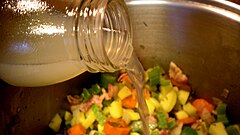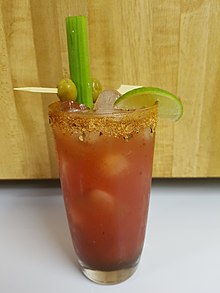
Clam juice is a broth derived from steamed clams,[1] which can be consumed on its own or used as an ingredient in various dishes and beverages.
Preparation[edit]
Clam juice is typically prepared from the liquid obtained from steamed clams.[1] Clam juice may be prepared fresh for consumption,[2] or purchased in prepared bottled form.[1][3] Some companies mass-produce prepared clam juice, which is made by steaming fresh clams in water with salt, collecting the extracted liquid known as clam extract or clam liquor, and then filtering it.[1][4]
In 1937, William G. Frazier invented a clam opener devised to easily open clams and retain all of the clam juice, which was collected in a bowl.[5] A patent for the clam opener was issued by the United States Patent and Trademark Office on November 15, 1938.[5]
Use in dishes[edit]

Clam juice is sometimes used in the preparation of clam chowder and other chowders.[3] It may be used as an ingredient in various sauces and meat sauces, seafood dishes, in soup bases, and as a condiment to top foods, similar to the manner that fish sauce may be used.[1][6][7]
Italian chefs sometimes use clam juice as an ingredient in seafood dishes and pasta sauces.[1] It is sometimes used during the deglazing process in cooking.[1] It may provide a mineral-like flavor to dishes, and serve as a substrate to assist in combining flavors present in a dish.[1]
As a beverage[edit]
Some restaurants and bars in the US serve shots of pure clam juice.[8] For example, the Old Clam House in San Francisco, California serves a shot glass of hot clam juice at the beginning of each meal.[8] In the early 1900s in the United States, clam juice was purported to be a hangover remedy.[1]

The Everleigh Club, a former brothel in Chicago, Illinois, that was in operation from 1900 to October 1911, would serve iced clam juice and a tablet of aspirin as a starter for breakfast, which began at 2:00 in the afternoon.[9][10]
Beverages with clam juice[edit]
Soda fountains[edit]
In the United States in the early 1900s, clam juice was used as an ingredient for various beverages at soda fountains.[11] Beverages prepared with clam juice included hot clam juice, hot clam soda, hot ginger clam broth, hot celery punch, hot clam cream, clam night cap, tomato clam broth and others.[11][12][13][14]
During this time, a recipe for hot clam juice used one-half to one-ounce of clam juice in an eight-ounce glass, the remainder of which was filled with hot water.[11] Accompaniments included soda crackers, celery salt, salt and pepper.[11] The beverage was sometimes prepared with the addition of milk or hot milk.[11] The addition of a small portion of butter would enhance the flavor of hot clam juice.[11]
Cocktails[edit]
In contemporary times, clam juice is sometimes used as an ingredient or drink mixer in cocktails, such as the Caesar,[2][15][16] also known as a Bloody Caesar.[17]
Clamato[edit]

Clamato is a mass-produced beverage prepared with tomato juice concentrate, clam juice and spices.[18][19] It also contains high fructose corn syrup, monosodium glutamate, salt and ascorbic acid.[19] Clamato is used as an ingredient in the Caesar cocktail.[20] The michelada, a beer cocktail, is sometimes prepared using Clamato as an ingredient.[21]
See also[edit]
- Clam sauce
- Fred Fear & Company – a former U.S. purveyor of clam juice
- List of juices
- Oyster sauce
 Drink portal
Drink portal
References[edit]
- ^ a b c d e f g h i Werner, Tommy (March 20, 2015). "What's your pantry (and cocktail) missing? Clam Juice". Epicurious. Retrieved January 19, 2016.
- ^ a b O'Hara, C.B.; Nash, W.A. (1999). The Bloody Mary: A Connoisseur's Guide to the World's Most Complex Cocktail. Lyons Press Series. Lyons Press. p. 77. ISBN 978-1-55821-786-7. Retrieved January 19, 2016.[permanent dead link]
- ^ a b Broyles, Addie (December 28, 2015). "Ring in New Year with fresh chowder". The Seattle Times. Retrieved January 19, 2016.
- ^ "Clam Juice". Cook's Illustrated. November 2008. Retrieved January 19, 2016.
- ^ a b "Patent US 2136816 A". United States Patent and Trademark Office. November 15, 1938. Retrieved 19 January 2016.
- ^ Chiarella, Tom (March 2, 2013). "The Endorsement: Clam Juice". Esquire. Retrieved January 19, 2016.
- ^ Burros, Marian (March 20, 1996). "Seafood, Pasta And Spice". Chicago Tribune. Retrieved January 19, 2016.
- ^ a b Lybarger, Jeremy (December 17, 2015). "The Old Clam House: Time-Worn Gem Turned Into Just Another Tourist Trap". SF Weekly. Archived from the original on January 26, 2016. Retrieved January 19, 2016.
- ^ Tait, Elaine (February 16, 1997). "Bordello Cooking: Mmm, Mmm Good!". The Philadelphia Inquirer. Retrieved January 19, 2016.
- ^ Washburn, Charles (1934). "Come Into My Parlor" (PDF). National Library Press. p. 156. Retrieved 19 January 2016.
- ^ a b c d e f The Dispenser Soda Water Guide. D.O. Haynes & Company. 1909. p. 122.
- ^ Fountain, Soda (1915). The Dispenser's Formulary, Or, Soda Water Guide. D.O. Haynes. p. 92.
- ^ Fox, Irving P. (1911). "The Spatula". Volume 18. Spatula Publishing Company. p. 157. Retrieved 19 January 2016.
- ^ Practical Druggist and Pharmaceutical Review of Reviews. Lillard & Company. 1920. p. 60.
- ^ McCart, Melissa (December 31, 2015). "On the Table: Kick off the year with a bloody mary". Pittsburgh Post-Gazette. Retrieved January 19, 2016.
- ^ "Best Caesar". Canadian Broadcasting Corporation. April 10, 2013. Retrieved January 19, 2016.
- ^ "Calgary's Bloody Caesar hailed as nation's favourite cocktail". Canadian Broadcasting Corporation. May 13, 2009. Retrieved January 19, 2016.
- ^ Drane, Amanda (January 8, 2016). "Madame Barfly: The Library in Easthampton is about the booze, not the books". Daily Hampshire Gazette. Retrieved January 19, 2016.
- ^ a b O'Brien, Erin (February 20, 2008). "Drinking Responsibly". Cleveland Free Times. Archived from the original on May 17, 2008. Retrieved January 19, 2016.
- ^ Paul Harrington & Laura Moorhead (1998). Cocktail: the drinks bible for the 21st century. Designed and illustrated by Douglas Bowman. New York: Viking. pp. 68–69. ISBN 978-0-670-88022-5.
- ^ Gold, Jonathan (October 31, 2015). "At Colonia Publica, come home to a warm bowl of fideo". Los Angeles Times. Retrieved January 19, 2016.
Further reading[edit]
- Burnette, J.A.; Flick, G.J.; Miles, J.R.; Ory, R.L.; St. Angelo, A.J.; Dupuy, H.P. (March 1983). "Characterization and Utilization of Ocean Quahog (Arctica islandica) Clam Juice as a Liquid and Dehydrated Flavoring Agent". Journal of Food Science. 48 (2): 353–359. doi:10.1111/j.1365-2621.1983.tb10742.x. (subscription required)
- Burnette, J.A. (1979). Effect of Processing on Flavor and Acceptability of Clam Juice Obtained from the Ocean Quahog, A̲r̲c̲t̲i̲c̲a̲ I̲s̲l̲a̲n̲d̲i̲c̲a̲. Virginia Polytechnic Institute and State University. Retrieved January 19, 2016. 172 pages.
- Hill, Edward C. (M.D.) (1905). "Rational Diet in Disease". Medical News. Henry C. Lea's Son & Company.
Clam juice may be tried in the vomiting of pregnancy (Thompson).
p. 586.

Well, that’s interesting to know that Psilotum nudum are known as whisk ferns. Psilotum nudum is the commoner species of the two. While the P. flaccidum is a rare species and is found in the tropical islands. Both the species are usually epiphytic in habit and grow upon tree ferns. These species may also be terrestrial and grow in humus or in the crevices of the rocks.
View the detailed Guide of Psilotum nudum: Detailed Study Of Psilotum Nudum (Whisk Fern), Classification, Anatomy, Reproduction